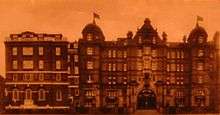Union Jack Club

The Union Jack Club is an Armed Forces Club in central London for members and veterans of the British Armed Services (and their families), including serving members of the Volunteer Reserve Forces, below commissioned rank. Located near Waterloo Station, the club has over 290 rooms for accommodation (single, twin, double and flats), a restaurant, bar, small library and function rooms.
The club's main entrance is now in Sandell Street off Waterloo Road, opposite Waterloo Station. There are views of London from the upper floors, where many of the accommodation rooms are located.
History

The idea in creating the club came from Ethel McCaul,[1] a Royal Red Cross nurse who was served in field hospitals during the South African War at the start of the 20th century. While officers had the benefit of memberships at the various gentlemen's clubs in London, non-commissioned personnel had no accommodations in the area and used public houses and inns of varying repute. The idea of a club was endorsed by such notables as Major-General Laurence Oliphant and Sir Edward Ward.[1]
The initial sum of £60,000 was raised at various galas and functions. Any donor giving £100 could name a room. Sir Arthur Conan Doyle took the opportunity to endow the "Lady Conan Doyle Room" with his contribution.[2]:84–6 Members of the royal family attended a benefit concert at the Royal Albert Hall
The Prince of Wales laid the foundation stone of the club in July 1904[2]:135 and later as King Edward VII with Queen Alexandra officially opened the club in July 1907.[2]:91 The original Edwardian building was located at 91 Waterloo Road and was completed at the end of 1904.
During World War II, the club gained a reputation as a refuge for homosexual servicemen to socialise and find intimacy. Despite the rooms being separated by mere partition walls, open at the ceiling, guests did not fear being reported to the military police, as the Union Jack Club's staff maintained an unofficial "blind eye" policy.[3]

Over the course of the war, the area around Waterloo Station was heavily bombed and the club damaged. In 1970, it was decided to demolish the original building and to construct a completely new one. Demolition began in 1971 and building started in 1972. The club's new premises opened on 16 October 1975. It was formally opened by the Patron-in-Chief, Queen Elizabeth II, on 12 February 1976.
See also
| Wikimedia Commons has media related to Union Jack Club. |
References
- 1 2 William Thomas Stead, ed. (1903). "The Review of Reviews". Office of the Review of Reviews: 262–3.
- 1 2 3 Brian W Pugh (3 October 2011). A Chronology Of The Life of Arthur Conan Doyle: A Detailed Account Of The Life And Times Of The Creator Of Sherlock Holmes. Andrews UK Limited. ISBN 978-1-78092-199-0.
- ↑ Senior Lecturer in History Emma Vickers (1 November 2015). Queen and Country: Same-Sex Desire in the British Armed Forces, 1939-45. Oxford University Press. p. 79. ISBN 978-1-78499-118-0.
External links
- Union Jack Club website
- The Queen and The Duke of Edinburgh help celebrate the centenary of the Union Jack Club, 3 December 2004
- London SE1 — Queen visits Union Jack Club, 3 December 2004
Coordinates: 51°30′13″N 0°06′39″W / 51.50361°N 0.11083°W